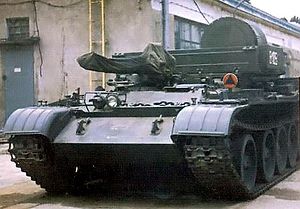|
WZTWZT (Wóz Zabezpieczenia Technicznego – armoured recovery vehicle) was a Polish post-World War II armoured recovery vehicle series. It consists of five versions. The first two, WZT-1 and WZT-2 were built on T-55/T-55A hull, the WZT-3 was built on T-72M hull, the WZT-3M was built on PT-91 hull and the WZT-4 was built on PT-91M hull for Malaysia. WZT-1
HistoryIn the early 50s USSR started developing an ARV built on the hull of T-54 that was just entering production. A prototype vehicle was completed after a short while and was named BTS-1 (BTS - Bronirowannyj Tjagacz Sriednij). Production was launched and it became the basic ARV of the Soviet army. In 1955 BTS-1 was upgraded with a hoist and a small folding crane. This upgraded version was given the name BTS-2. It was built on the T-54 hull and later on the T-55 hull. In the end of the 60s Poland and Czechoslovakia bought the BTS-2. Basing on BTS-2 technical data the Zakład Produkcji Doświadczalnej Zakładów Mechanicznych "Bumar-Łabędy" (Experimental Production Institute of "Bumar-Łabędy") prepared a prototype of WZT-1 ARV. It was accepted into the Ludowe Wojsko Polskie and became its basic ARV replacing the older designs. Production started in 1970 in "Bumar-Łabędy" and continued until 1978 when it was completely replaced by WZT-2. The WZT-1 were used in the upgrade of Newa SAM system to Newa-SC standard. The launcher was mounted on a WZT-1 chassis (many sources claim the vehicle to be T-55 tank but as a matter of fact vehicles never had tank turret in the first place). Upgrade replaced many analogue components with digital ones for improved reliability and accuracy also improving mobility and also adds IFF capability and data links. Unlike oryginal ARV variant the Newa launcher is still in use in the armed forces of Poland. OperatorsWZT-2
Polish ARV built on T-55 hull. It was built to perform repairs on T-55 and T-55A tanks. When it entered service in 1973 it was probably the best ARV in the Warsaw Pact. It is still able to carry out tasks that NATO gives ARVs of its class. Unlike the T-55 and the WZT-1, the WZT-2 is still the basic ARV of the Polish army used for field repairs. It can carry out repairs not only on Soviet tanks like the T-54/T-55 and T-72 but also on Polish PT-91 and German Leopard 2A4 tanks. However because all tanks currently in Polish service weigh more than 40 tonnes it is not able to tow them. It is used to tow lighter vehicles like BMP-1 and 2S1. A number of those vehicles are used by Ratownictwo Kolejowe (Railroad emergency response services).[1][2] Operators
 WZT-3
HistoryWhen the T-72 entered service with LWP in 1978 a need for a new ARV appeared. It was decided that T-72M hull will be used. Wojskowy Instytut Techniki Pancernej i Samochodowej (Military Institute of Automobile and Armour Technology) from Sulejówek pointed out the main requirements of the vehicle and Ośrodek Badawczo-Rozwojowy Urządzeń Mechanicznych in Gliwice made two prototypes caring out the Bizon (Bison) program. Tests and trials were carried out from 1986 to 1988 and it was immediately accepted into the Polish Army. During a short production run 20 of those vehicles were made until 2003 when they were all upgraded to the WZT-3M standard. Operators
Former operators
WZT-3M
HistoryWhen PT-91 entered service in Polish army it was decided that the WZT-3 which was based on T-72M should be upgraded with elements from PT-91. The upgraded variant was given WZT-3M designation. The main difference was the engine. The original WZT-3 had a 780 hp (582 kW) 12-cyl. diesel engine from T-72M. The WZT-3M has an 850 hp (634 kW) PZL-Wola S12U 12-cyl. 38.9 litre diesel from PT-91. During initial production run 9 vehicles were made before 2003 when 20 of the old WZT-3 were upgraded to the WZT-3M standard. Operators
References
|
||||||||||||||||||||||||||||||||||||||||||||||||||||||||||||||||||||||||||||||||||||||||||||||||||||||||||||||||||||||||||||||||||||||||||||||||||||||||||||||||||||||||||||||||
Portal di Ensiklopedia Dunia



